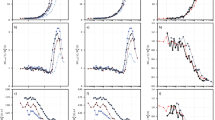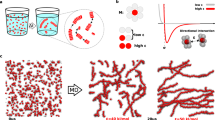Abstract
UNLIKE small-molecule liquids, polymer melts can display complex and often highly non-newtonian flow behaviour, which reflects the dynamics of the entangled polymer chains. Star-branched polymers, which have f arms each containing Na monomeric units, joined covalently at a common branch point, provide good model systems for understanding the slow dynamics of branched polymers. These dynamics may be probed by measurement of the diffusion coefficient, D. It is well established1–3 that for three-armed star polymers, Dα exp(–αNa), where α is a constant. This result is consistent with early theories4,5, which assumed that to diffuse, all but two arms of the star must retract simultaneously to the branch point; these theories predict Dα exp(–α(f–2)Na). Here we present experimental measurements of D for polymers with f = 3–12, which indicate a much weaker decrease with f: Dα exp (–0.41f). This result is consistent with more recent theories6 which predict that a star can diffuse by retracting just one arm at a time.
This is a preview of subscription content, access via your institution
Access options
Subscribe to this journal
Receive 51 print issues and online access
$199.00 per year
only $3.90 per issue
Buy this article
- Purchase on Springer Link
- Instant access to full article PDF
Prices may be subject to local taxes which are calculated during checkout
Similar content being viewed by others
References
deGennes, P-G. J. Phys. 36, 1199–1207 (1975).
Klein, J., Fletcher, D. & Fetters, L. J. Nature 304, 526–527 (1983).
Antonietti, M. & Sillescu, H. Macromolecules 19, 798–803 (1986).
Graessley, W. W. Adv. Polym. Sci. 47, 67–117 (1982).
Klein, J. Macromolecules 19, 105–118 (1986).
Rubinstein, M. Phys. Rev. Lett. 24, 3023–3026 (1986).
Pennisi, R. W. & Fetters, L. J. Macromolecules 21, 1094–1099 (1988).
Mills, P. J., Green, P. F., Palmstøm, C. J., Mayer, J. W. & Kramer, E. J. Appl. Phys. Lett. 45, 957–959 (1984).
Green, P. F., Mills, P. J. & Kramer, E. J. Polymer 27, 1063–1066 (1986).
Shull, K. R., Kramer, E. J., Hadziioannou, G., Antonietti, M. & Sillescu, H. Macromolecules 21, 2578–2580 (1988).
Graessley, W. W. & Roovers, J. Macromolecules 12, 959–965 (1979).
Bates, F. S. & Wignall, G. D. Macromolecules 19, 932–934 (1986).
Green, P. F. & Doyle, B. L. Macromolecules 20, 2471–2474 (1987).
Ferry, J. D. Viscoetastic Properties of Polymers 3rd edn (Wiley, New York, 1980).
Author information
Authors and Affiliations
Rights and permissions
About this article
Cite this article
Shull, K., Kramer, E. & Fetters, L. Effect of number of arms on diffusion of star polymers. Nature 345, 790–791 (1990). https://doi.org/10.1038/345790a0
Received:
Accepted:
Issue Date:
DOI: https://doi.org/10.1038/345790a0
Comments
By submitting a comment you agree to abide by our Terms and Community Guidelines. If you find something abusive or that does not comply with our terms or guidelines please flag it as inappropriate.



